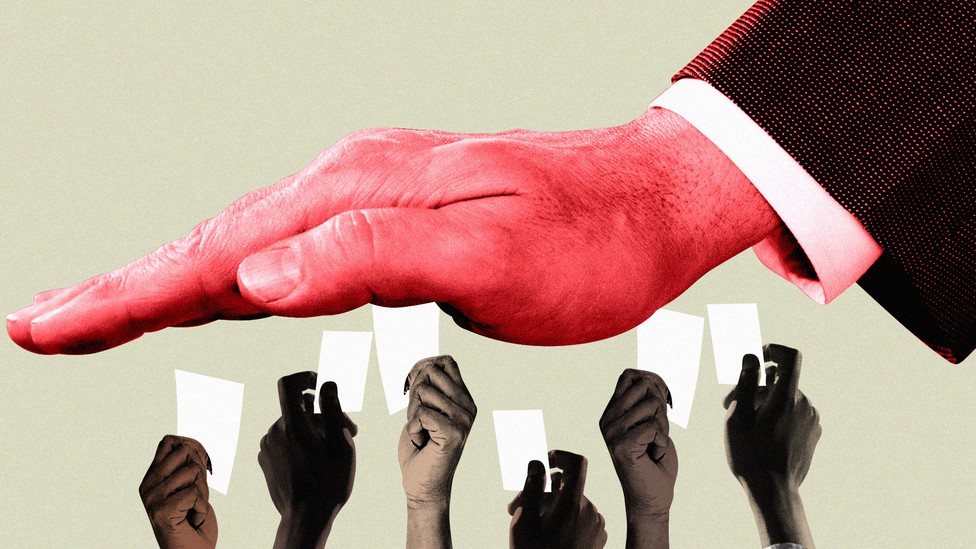In last week’s blog post, we provided an overview of Juneteenth and featured a timeline showing major historical events from the Civil War to the present. While progress has been made since the original Juneteenth in 1865, the United States continues to witness structural racism and the suppression of political participation by Black and brown communities. Today’s post focuses on two interrelated systems that propagate racism: voter suppression and mass incarceration.
The present-day assault on voting rights is reminiscent of the anti-voting legislation passed during the Jim Crow era. Politicians today who endorse the new anti-voting laws in Georgia and Florida, as well as more than 360 anti-voting bills across 47 states, often claim that stricter voter identification requirements would protect the “integrity” of the vote; however, these laws are a form of structural racism that — in practice — disproportionately reduce political participation by Black, brown, and rural communities.
Stricter voter identification requirements can disadvantage minority and rural communities. For example, while proofs of identification in states such as Georgia are “free,” there are many hidden costs, as highlighted by Stacey Abrams: “You may not have to pay a fee, [but] you’ve got to pay for the birth certificate, you’ve got to pay for all the documentation that leads up to being able to get that ID. And there is a cost, especially to rural communities, that often do not have transportation or access to the DMVs, which are not on every street corner. So there’s a very real cost to voters to secure this ID.”
Other structures, such as mass incarceration, evolved out of a similar history of racial oppression. A growing body of research posits that “incarceration is part of a lineage of punitive institutions used to enforce the racial hierarchy in the United States.” At the beginning, slavery was the primary mode of enforcement. However, after slavery was abolished, Jim Crow laws were used to preserve racist structures in society. When Jim Crow was outlawed, mass incarceration was implemented as a seemingly “color-blind” approach to maintain the racial hierarchy. A study at the University of Chicago by Gottlieb and Flynn (2021) supports this theory: Researchers found that “a criminal charge in a county with high levels of slavery in 1860 increases the likelihood of pretrial detention, the probability of a sentence of incarceration, and the length of incarceration sentences.”
While mass incarceration may seem “color-blind” at first-glance, this is far from the truth. Data show that pre-trial detention and mass incarceration disproportionately affect Black and brown communities:
- In 2017, the adult imprisonment rate was roughly six times higher for Black people than it was for white people in the United States as a whole. In Washington state, Black people were incarcerated at 4.4 times the rate of white people.
- Black and brown people are more than 10-25% more likely than white people to be detained pretrial or to have to pay money bail.
- Median bond amounts are roughly $10,000 higher for Black people compared to white people. One study found that the median bond for Black people was twice the median bond for white people in the United States.
Additionally, mass incarceration is closely linked to voter disenfranchisement. In 48 states, people who have been incarcerated for felony convictions are barred from voting, either temporarily or permanently. This means that an inordinate number of Black citizens are excluded from the democratic process. The use of mass incarceration as a tool of racist oppression has deep roots in America’s history:
- Following the Reconstruction era, Southern states discovered a loophole in the Thirteenth Amendment, which had outlawed slavery: prison laborers could work for little to no money. Subsequently, the number of Black people in prisons increased dramatically. In Alabama in 1850, only ~2% of the prison population was nonwhite, but by 1870, the percentage skyrocketed to 74%. Southern states also began to rewrite their incarceration-related disenfranchisement laws to exclude Black people from the democratic process.
- The War on Drugs leveraged mass incarceration as a national tool for racially motivated oppression. In 1971, President Richard Nixon drastically increased the power of federal drug control agencies and implemented measures such as mandatory sentencing and no-knock warrants. In a 1994 interview, John Ehrlichman — Nixon’s domestic policy advisor — admitted that the “war on drugs” began as a racially motivated act focused on targeting Black communities and the anti-war left: “We knew we couldn’t make it illegal to be either against the war or blacks, but by getting the public to associate the hippies with marijuana and blacks with heroin and then criminalizing them both heavily, we could disrupt those communities.” This led to a spark in mass incarceration (a 700% growth in prison populations since 1970) which disproportionately affects Black communities (one out of three Black men are imprisoned in their lifetime, versus one out of seventeen white men).
…so what can you do?
Ending institutions of oppression — such as mass incarceration and the cash bail system — will help advance the fight for racial equity. To drive structural reform, we need to be active participants in the democratic political process and preserve the right to vote for all people.
Off-year elections, such as this year’s, can play a key role in shaping the criminal punishment system. The election of key positions that drive law enforcement policy, such as prosecutors and sheriffs, are often determined during off-years. In many cases, these roles are overlooked and uncontested.
In honor of Juneteenth and the people that have fought for equal freedom, rights, and enfranchisement, we encourage you to exercise your right to vote during the 2021 elections. Over the next several weeks, we will be sharing additional information and resources on voting in Washington state’s upcoming election. In the meantime, these are the key election dates to keep in mind:
- Washington Primary Elections — Municipal Election: August 3, 2021
-
- Early voting: July 16, 2021 – August 3, 2021
- Voter registration deadline:
- Online or post received by July 26, 2021
- Election day registration and voting: August 3, 2021
- Deadline to request an absentee ballot:
- In person request by August 3, 2021 at 8 PM PDT
- Deadline to return completed absentee ballot: August 3, 2021
- Washington General Elections — Municipal Election: November 2, 2021
-
- Early voting: October 15, 2021 – November 2, 2021
- Voter registration deadline:
- Online or post received by October 25, 2021
- Election day registration and voting: November 2, 2021
- Deadline to request an absentee ballot:
- In person request by November 2, 2021 at 8 PM PDT
- Deadline to return completed absentee ballot: November 2, 2021
Sources:
- https://nmaahc.si.edu/blog-post/historical-legacy-juneteenth
- https://www.cnn.com/interactive/2021/05/politics/black-voting-rights-suppression-timeline/
- https://www.usatoday.com/story/news/2021/03/05/black-voting-rights-reconstruction-jim-crow/6919352002/
- https://www.cnn.com/2021/04/03/politics/state-legislation-voter-suppression/index.html
- https://www.journals.uchicago.edu/doi/pdf/10.1086/713922
- https://www.prisonpolicy.org/blog/2019/10/09/pretrial_race/
- https://theappeal.org/political-report/when-are-elections-for-prosecutor-and-sheriff/
- https://theappeal.org/justice-in-america-episode-5-excluded-from-democracy/
- https://www.brennancenter.org/our-work/analysis-opinion/race-mass-incarceration-and-disastrous-war-drugs
- https://www.aclu.org/issues/smart-justice/mass-incarceration
Last updated: June 24, 2021
Featured Image credit: https://www.theatlantic.com/politics/archive/2018/07/poll-prri-voter-suppression/565355/

